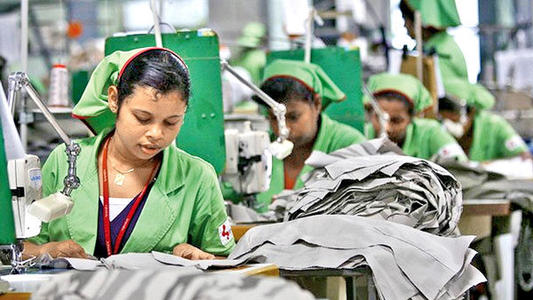The status quo of the seven major textile countries, with a significant decline in exports
Aug 28, 2020 | by Zhao xh

The negative impact of the COVID-19 pandemic on the global economy is still deepening, and the global textile industry have been affected by it. Exports have fallen, orders are insufficient, applications for suspension, production cuts...
Vietnam: This year’s textile and apparel exports are expected to drop by 16%
According to statistics from the Ministry of Industry and Commerce of Vietnam, the export volume of various yarns in the first 7 months of 2020 decreased by 20.9% compared with the same period in 2019; fabrics decreased by 40%; processed textiles decreased by 12.1%. The department reminded that in the second half of 2020, Vietnamese textile companies will need to strengthen the development of the Vietnamese domestic market and reduce production and management costs to make up for their revenue, while maintaining product quality, resetting production lines and manpower deployment measures to reduce the impact of the COVID-19 pandemic.
Global data analysis company estimates that the Asia-Pacific region’s apparel and footwear industry will lose USD 95.4 billion in sales this year. The global textile industry sales will decrease by USD 395.6 billion, down 19.5% from last year, accounting for 29.1% of the total retail industry revenue loss (USD 1.3617 trillion).
On August 2, the Vietnamese textile group Vinatex made a forecast that the export of Vietnamese textiles in the second half of 2020 will continue to show a downward trend, with a decline of as much as 14 - 18%, so that the total textile exports in 2020 may reach USD 32.75 billion, decrease by 16% compared with 2019. As of the end of July, most Vietnamese textile companies have not received orders for high-value-added products such as suits and high-end shirts in the second half of 2020; and orders for masks and protective clothing have also dropped sharply due to the sufficient international supply. If export orders for masks and protective clothing continue to decrease, the Vietnamese textile industry will face greater difficulties in the last few months of 2020.
At present, the pandemic situation in the traditional textile export markets of Vietnam, such as the EU and the United States, has not yet been fully controlled; in addition, the pandemic has returned in Da Nang City, Vietnam on July 25, and the number of confirmed cases has increased to about 100 in just one week. The first death occurred on July 31. Under these unfavorable factors, the production, operation and export activities of the Vietnamese textile industry are bound to be affected. The EU-Vietnam Free Trade Agreement (EVFTA), which came into effect on August 1, may not be able to bring the benefits to the Vietnamese textile industry in the short term.
Bangladesh: Exports in January next year may return to the level before the pandemic
According to data from the Bangladesh Textile Mills Association, affected by the COVID-19 pandemic, Bangladesh’s cotton imports in the 2019/20 fiscal year were 7.1 million bales, a year-on-year decrease of 13.4%, the first decrease in more than a decade.
Since the lifting of the pandemic blockade on May 30, most textile factories have resumed production. Although the international cotton price has fallen sharply before, the factories are still using the previous stock cotton, and many importing companies have also delayed picking up the goods from the port. However, with the recovery of downstream demand, the product inventory of textile mills has been greatly reduced, so the demand for cotton imports will increase from now on. on May 30, most textile factories have resumed production. Although the international cotton price has fallen sharply before, the factories are still using the previous stock cotton, and many importing companies have also delayed picking up the goods from the port. However, with the recovery of downstream demand, the product inventory of textile mills has been greatly reduced, so the demand for cotton imports will increase from now on.
At present, the capacity of most garment factories in Bangladesh has recovered to about 75%, which shows that orders are recovering smoothly. Industry insiders said that if international buyers continue to purchase from Bangladesh at the current pace, the country’s demand for cloth will continue to increase after September.
According to the Bangladesh Textile Manufacturers Association, by July, more than 50% of Bangladesh’s annual cloth sales orders have been completed. It is expected that 75% of the orders will be completed by September. All tasks will be completed by the end of the year. Exports will resume the level before the pandemic in January next year.
Cambodia: The fourth quarter is not optimistic
Under the dual pressure of the COVID-19 pandemic and the abolition of EBA, the Cambodian textile and garment industry is facing great difficulties. Since the beginning of the year, about 250 companies have suspended or closed operations, and 150,000 employed workers have become unemployed, mainly female workers. It is expected that only 30% of the member companies’ orders in the third quarter of this year will be the same as last year, and the rest will have declined to varying degrees. In the fourth quarter, less than 20% of members expect orders to be flat. Due to the cancellation of the EBA tariff preference measures, the export prices of Cambodian clothing products to the EU market have relatively increased, and orders from the EU have dropped significantly. In order to save costs, many garment manufacturers are currently shutting down production. The Cambodian government has certain support for related companies. The company pays workers a minimum wage of USD 30 a month and the government subsidizes USD 40 to help companies resist the impact of the pandemic.
Myanmar: Nearly 10 companies apply for closure
The Director of the Myanmar Directorate of Investment and Company Administration (DICA) Tan Hin Lun said that the Myanmar Investment Commission (MIC) has received applications for closure of approximately 10 companies. According to the Myanmar Investment Law, the establishment of an enterprise approved by the MIC must be approved before it can officially cease business, and the taxation department must check the tax status. He said that due to the impact of the COVID-19 pandemic, some companies are reducing the scale of production and are even forced to close temporarily or permanently. Individual business owners ran away and did not pay workers’ wages.
It is reported that as of June 21 this year, 100 garment and textile companies and 63 other companies have closed, and more than 54,000 workers have lost their jobs. Currently, 101 companies have resumed operations and more than 15,000 workers have returned to work.
The pandemic has a greater impact on Myanmar’s economy, and the sharp drop in European and American orders has dealt a major blow to the future development of the apparel industry. The survey shows that 70% of garment factories are not confident that orders will return to previous levels. At present, many companies are also looking for new development opportunities, such as switching to production of masks and other pandemic prevention materials.
Indonesia: Textile industry sales surge due to outbreak
Under the influence of the global pandemic, since Indonesia has not yet deeply integrated into the global supply chain, the global health emergency triggered by the coronavirus may not have a serious impact on the Indonesian economy.
As factories look for alternative materials from outside of China, Indonesian textile and apparel companies have received new domestic and international orders this year, which has increased by about 10%. According to Indonesian company personnel, while the Asian textile and clothing industry is facing bankruptcy and layoffs, Indonesian textile and clothing companies have made huge fortunes due to delays in shipments caused by the outbreak and spread of the pandemic.
Sutanto, deputy chief executive officer of PT PanBrothers, headquartered in Tangerang, said the growth rate of the company in the second and third quarters was 20% higher than expected. The textile-to-apparel company initially predicted that sales this year would increase by 15%. Iwan Lukminto, CEO of PT Sri Rejeki Isman, one of Southeast Asia’s largest textile and apparel manufacturers, said the company’s orders have also seen an additional 15% increase.
These orders are all orders placed by local garment factories that produce garments for global brands. With the approval of the Indonesia-Australia Free Trade Agreement this year, sales of textiles and clothing are expected to rise. According to the “Indonesia-Australia Free Trade Agreement,” Australia will cut 5% import tariffs on textiles and clothing products.
Laos: Enterprises generally face shortage of orders
Laos itself has a relatively small clothing industry, and the impact of the pandemic this time is the largest among all countries. Xaybandith, chairman of the Lao Garment Manufacturers Association, said that the old garment industry is highly dependent on imports, and the closure of ports due to the pandemic has had a significant impact on the supply of raw materials for the industry. Affected by the pandemic, imports from Thailand, China, Vietnam and other places are still relatively smooth, but import inspections are extremely strict. Starting from April, only the pandemic prevention work meets the requirements, and the factory where there are employee dormitories or employees living near the factory can obtain the start-up certificate for production, so the vitality of the entire industry is seriously insufficient. Some companies hope to find new exports by converting production of anti-pandemic materials, but due to various reasons such as raw materials and equipment, only three companies have successfully converted. At present, Lao clothing companies are generally facing a shortage of orders and will face greater pressure for future development.
Thailand: Production cuts respond to declines in exports
Thailand has a relatively complete textile and apparel industry chain, but the impact of the pandemic on Thailand’s industry cannot be underestimated. Jumnong, chairman of the National Federation of Thai Textile Industries (NFTTI), said that the export of Thailand’s textile and apparel industry has fallen by 17% year-on-year, while imports have fallen by 19%. Among them, imports from China decreased by 12%, and imports from ASEAN decreased by 16%. Due to insufficient orders, most Thai textile and garment enterprises are currently operating by reducing production, and some factories only operate 4 days a week. Dyeing and printing companies that were originally operating at full capacity are currently shut down for one day a week. However, some companies are looking for new ways in the crisis, developing antibacterial products and exporting them to Japan, and have achieved good results. Since the beginning of this year, some factories have looked for new opportunities and expanded their production capacity, and more than a dozen new factories have started operation. The ThaiTex project under government support is also actively supporting the development of the industry.








